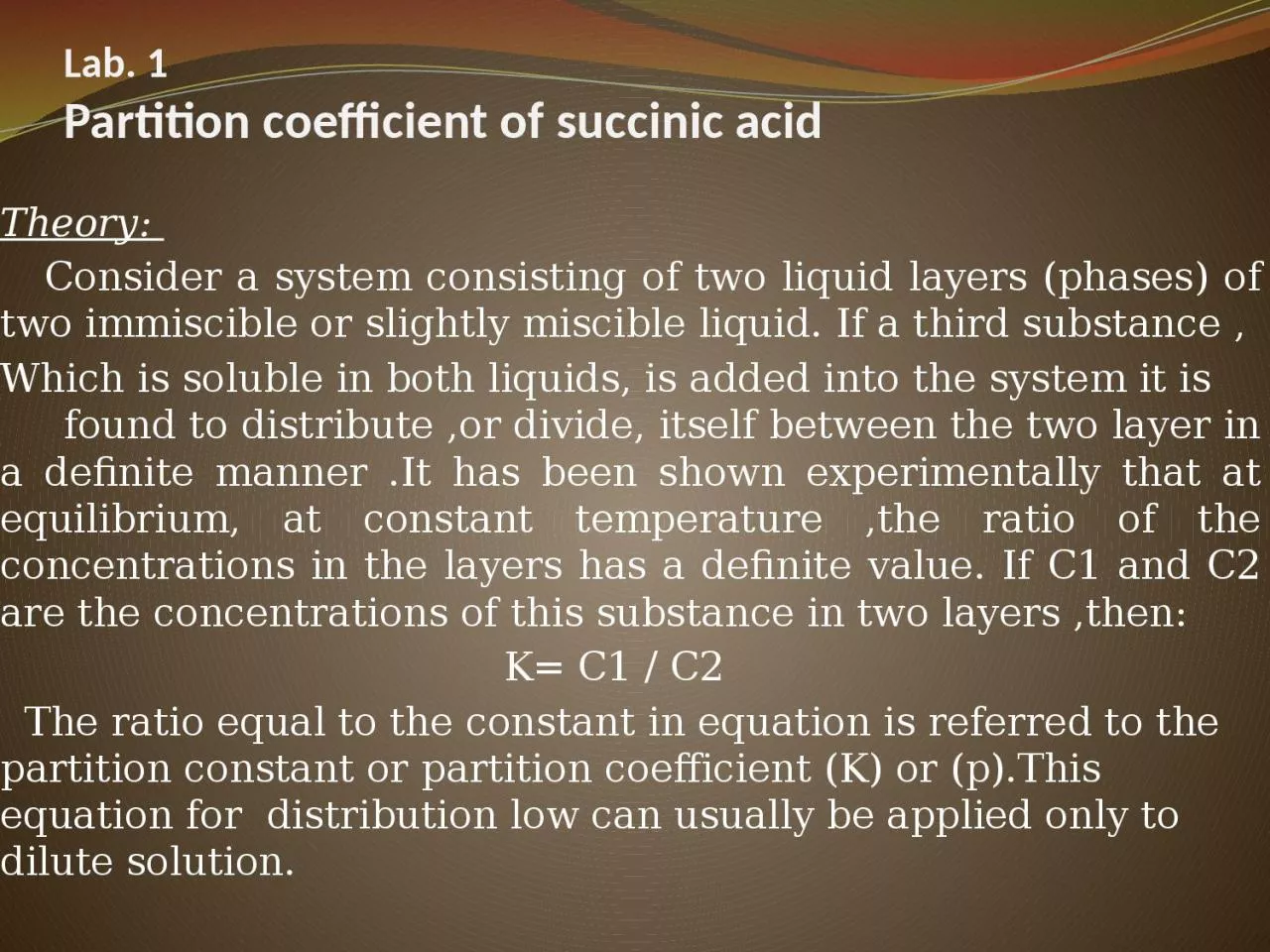

succinic acid Theory Consider a system consisting of two liquid layers phases of two immiscible or slightly miscible liquid If a third substance Which is soluble in both liquids is added into the system it is found to distribute or divide itself between the two layer in a ID: 1022119
Download Presentation The PPT/PDF document "Lab. 1 Partition coefficient of" is the property of its rightful owner. Permission is granted to download and print the materials on this web site for personal, non-commercial use only, and to display it on your personal computer provided you do not modify the materials and that you retain all copyright notices contained in the materials. By downloading content from our website, you accept the terms of this agreement.
1. Lab. 1Partition coefficient of succinic acidTheory: Consider a system consisting of two liquid layers (phases) of two immiscible or slightly miscible liquid. If a third substance ,Which is soluble in both liquids, is added into the system it is found to distribute ,or divide, itself between the two layer in a definite manner .It has been shown experimentally that at equilibrium, at constant temperature ,the ratio of the concentrations in the layers has a definite value. If C1 and C2 are the concentrations of this substance in two layers ,then: K= C1 / C2 The ratio equal to the constant in equation is referred to the partition constant or partition coefficient (K) or (p).This equation for distribution low can usually be applied only to dilute solution.
2.
3. Hence both the partition and distribution coefficient are measures of how hydrophilic ("water-loving") or hydrophobic ("water-fearing") a chemical substance is. Partition coefficients are useful in estimating the distribution of drugs within the body. Hydrophobic drugs with high octanol/water partition coefficients are preferentially distributed to hydrophobic compartments such as the lipid bilayers of cells while hydrophilic drugs (low octanol/water partition coefficients) preferentially are found in aqueous compartments such as blood serum
4. The most common physicochemical descriptor is the molecules partition coefficient in an octanol/watre system. For example an orally administered drug will go through a series of partitioning steps:1- Leaving the aqueous extracellular fluids.2- Passing through lipid membranes.3- Entering other aqueous environments before reaching the receptor.In this sense, a drug is undergoing the same partitioning phenomenon that happens to any chemical in a separatory funnel containing water and a non- polar solvent as hexane, chloroform, or ether.Not that there are dynamic changes occurring to the drug ,such as it being metabolized, bound to serum albumin, excreted from the body , and bound to receptor.
5. The partition coefficient (P) is the ratio of the molar concentration of chemical in the non- aqueous phase (usually 1- octanol) versus that in the aqueous phase, it is one of the main physiochemical properties of drug and is the most important property for determining the distribution and partitioning of a drug through the lipid bilayer.The most widely used solvent is 1- octanol ,why?What is the difference between the separatory funnel model and what actually occurs in the body?What is the application of partition coefficient in pharmacology.
6. Succinic acid is a carboxylic (diprotic acid),process of titration is based on the neutralization reaction.
7. Funnel no.Succinic acid solution,ml(Butanedioic acid)Water, ml1-Butanol, ml1200152155 153101015451515Procedure:
8. Red the volumes of NaOH from the burette(Vt), write it in table.Calculate the average volume of titrant for the same solution, write it in table.Calculate the concentration of Succinic acid in the aqueous layer.Calculate the concentration of Succinic acid in the organic layer(1-Butanol)Calculate the partition coefficient K of Succinic acid at each composition of partition mixture.